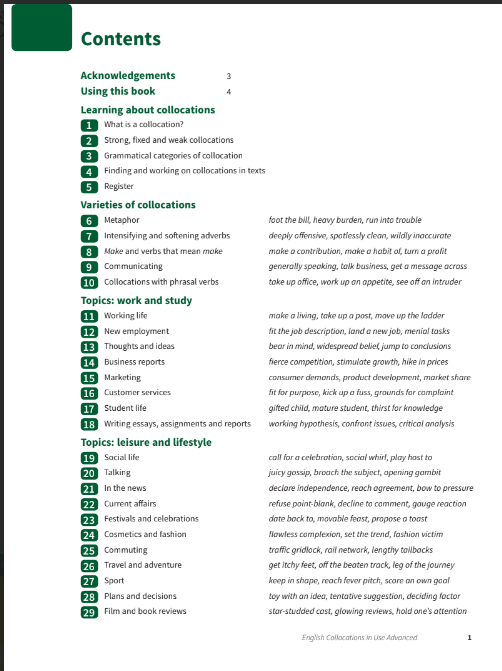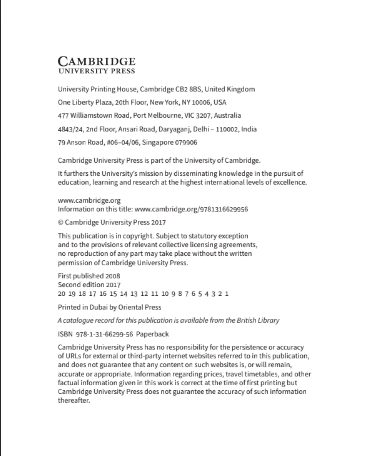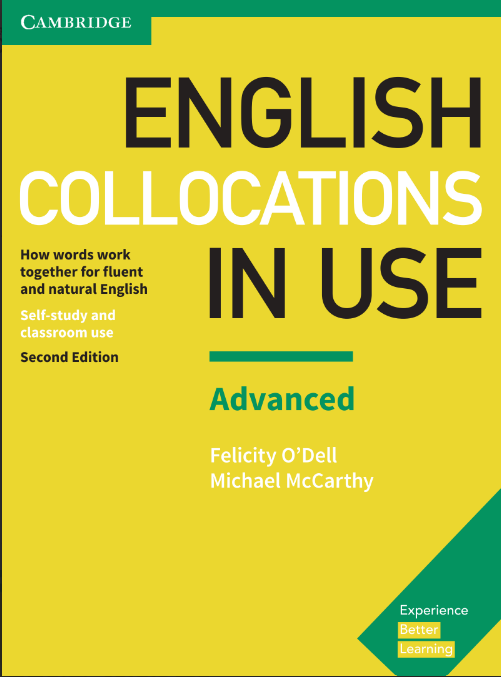


Acknowledgements** **Acknowledgements** Joy Godwin wrote two new units for the Second Edition: Unit 15, Marketing, and Unit 25, Commuting. The publishers would like to thank Joy for her contribution to this edition. The authors and publishers acknowledge the following sources of copyright material and are grateful for the permissions granted. While every effort has been made, it has not always been possible to identify the sources of all the material used, or to trace all copyright holders. If any omissions are brought to our notice, we will be happy to include the appropriate acknowledgements on reprinting and in the next update to the digital edition, as applicable. **Text:** NI Syndication Limited for the text on p. 12 adapted from ‘I need help with my homework’ by Rebecca O’Connor, The Times, 24.03.2007. Copyright © NI Syndication Limited. Eye For Film for the text on p. 12 adopted from ‘The Interpreter’ by Angus Wolfe Murray, http://www.eyeforfilm.co.uk/review/ the-interpreter-film-review-by-angus-wolfe-murray. Copyright © 2005 Eye For Film. Reproduced with permission; HostelBookers.com Ltd. for the text on p. 56 adapted from ‘A selection of Great European Train Routes, London-Tangiers’. Copyright © HostelBookers.com Ltd. Reproduced with kind permission. Key: T = Top, B = Below, TR = Top Right, CL = Centre Left, CR = Centre Right, BL = Below Left. **Photographs** All the photographs are sourced from Getty Images. p. 12: Andersen Ross/Photodisc; p. 24: Eugenio Marongiu/Cultura; p. 26 (TL): plume creative/DigitalVision; p. 26 (BL) & p. 90 (photo 1): Uppercut Images; p. 26 (BL): Vladimir Godnik; p. 28 (TR): Yuri_Arcurs/DigitalVision; p. 28 (TL): jastkall/iStock; p. 31: Kevin Sin/Blend Images; p. 33: David Malan/Photographer’s Choice RF; p. 47: Marcoly/Photodisk; p. 50 (TR): Edwin-Bernstein/Photon; p. 50 (BL): Ned Frisk/Blend Images; p. 52 (TL): CoffeeAndMilk/E+; p. 52 (TR): Garo/PHANIE/Canopy; p. 52 (CL): BSIP/Universal Images Group; p. 52 (BR): CoffeeAndMilk/Vetta; p. 54 (GREG): kali8/E+; p. 54 (Moelew): Stone; p. 63 (photo 1): Auscape/UIG/Universal Images Group; p. 63 (photo 2): Thomas Barwick/Iconica; p. 63 (photo 3): Jose Luis Peláez/The Image Bank; p. 63 (photo 4): lissart/iStock/Getty Images Plus; p. 63 (photo 5): David Malan/Photographer’s Choice; p. 63 (photo 6): Mike Kemp/Blend Images; p. 64: gpointstudio/iStock; p. 65 (photo 1): <Gbplipics/Westend61>; p. 65 (photo 2): Flying Colors Ltd/DigitalVision; p. 65 (photo 3): eyjafjallajokull/iStock/Getty Images Plus; p. 68 (CL): Ken Wiedemann/iStock; p. 68 (CR): Ray Kasprzak/The Image Bank; p. 68 (BL): Whites/ iStock; p. 68 (CR): Antenna; p. 70: inhousecreative/Getty Images Plus; p. 76: vadimuguzhva/ iStock; p. 79: Nico Kai/The Image Bank; p. 81: Roberto Machado Noa/LightRocket; p. 84: David Lees/DigitalVision; p. 85 (TL) & (CL): Juanmonino/E+; p. 85 (TR): John Rensten/Photographer’s Choice; p. 85 (CR): ioogga the Image Bank; p. 85 (BL): visualspace/iStock; p. 87: Commercial Eye/ The Image Bank; p. 94: Peter Dazely/Photographer’s Choice; p. 90: kwatt/Bookmedia Ltd/Getty Images Plus; p. 92 (TL): askeei/E+; p. 92 (BR): Briti/Veerle; p. 95: Claudia Bucher/Zoonar; p. 103: Jetta Productions/Blend Images; p. 104 (TR): EmirMemedevski; p. 104 (BR): Kevin C Moore/ Cultura; p. 104 (CR): Peopleimages/DigitalVision; p. 108: Amos Morgan/Photodisc; p. 119 (photo 1): Bernhard Lang/The Image Bank/iStock; p. 119 (photo 2): Michal Venera/Photolibrary; p. 119 (photo 3): Vasily Pindyurin; p. 126: Ken Redding/Corbis; p. 128 (TR): Carl Court/ p. 128 (BR): romdinka/ iStock; p. 134 (photo): E-Art/ iStock/Getty Images Plus; p. 132 (tablets): Matej Froloň/Photographer’s Choice; p. 132 (notebook): Angelika-Angelika/iStock/Getty Images Plus; p. 133: drb.images/E+; p. 136: 123ducu/iStock; p. 140: DEA/W. BUSS; p. 145: Paul Bradbury/Calaimage. **Illustrations** Ludmila (KJA Artists), Katie Mac (NB Illustration) and Miguel Diaz Rivas (Advocate Art). **Cambridge Dictionaries** The Cambridge Dictionaries are the world’s most widely used dictionaries for learners of English. The dictionaries are available in print and online at dictionary.cambridge.org. Copyright © Cambridge University Press. reproduced with permission. The publisher has used its best endeavours to ensure that the URLs for external websites referred to in this book are correct and active at the time of going to press. However, the publisher has no responsibility for the persistence or accuracy of URLs or any of the websites referred to, or for any content on such websites. If a website has changed, the publisher cannot guarantee the accuracy of the URL. — **Image 2: Using this book – Collocations** **Using this book** **What is a collocation?** Collocation means a combination of two or more words which frequently occur together. If someone says, ‘She’s got yellow hair’, they would probably be understood, but it is not what would ordinarily be said in English. We’d say, ‘She’s got blond hair’. In other words, yellow hair doesn’t collocate with hair in everyday English. Yellow collocates with, say, flowers or paint. Collocations are not just a matter of how adjectives combine with nouns. They can refer to any kind of typical word combination, for example verb + noun (e.g. arouse someone’s interest, lead a seminar), adverb + adjective (e.g. fundamentally different), adverb + verb (e.g. flatly contradict), noun + noun (e.g. a lick of paint, a team of experts, words of wisdom). There is much more about different grammatical types of collocation in Unit 3. Phrasal verbs (e.g. come up with, run up, adhere to) and compound nouns (e.g. economy drive, stock market) are sometimes described as types of collocation. In this book we consider them as indivisible lexical items and so shall include them here only in combination with something else, e.g. come up with a suggestion, run up a bill, adhere to your principles, go on an economy drive, play the stock market. However, it is not always easy to separate collocations and compounds and, where they are useful for learners as an important part of the vocabulary of a topic, we include some compounds in this book too. It can be difficult for learners of English to know which word’s collocate, as natural collocations are not always logical or guessable. There is, for example, no obvious reason why we say making friends rather than getting friends or heavy rain, not strong rain. Learners also need to know when specific collocations are appropriate. This is usually referred to by linguists as knowing which register to use. Alight from a bus is a formal collocation used in notices and other official contexts. In everyday situations we would, of course, always talk about getting off a bus. There is more about register and collocation in Unit 6. **Why is it important to learn collocations?** An appreciation of collocation will help you to: * use the words you know more accurately. * In other words, you’ll make (NOT ee) fewer mistakes. * Sound more natural when you speak and write. * By saying, for example, of great importance, rather than of big or high importance, you won’t just be understood, you will – quite rightly – sound like a fluent user of English. * Vary your speech and, how much more importantly, your writing. * Instead of repeating everyday words like very, good or nice, you will be able to exploit a wider range of language. You would gain more marks in an exam, for instance, for writing We had a blissfully happy holiday in a picturesque little village surrounded by spectacular mountains than for We had a very happy holiday in a nice little village surrounded by beautiful mountains, even though both sentences are perfectly correct. * A journalist, poet, advertiser or other inventive user of language often creates an effect by not choosing the expected collocation. For example, a travel article about the Italian capital might be entitled No place like Rome, a reference to the popular expression There’s no place like home. **How is the book organised?** The book has 60 two-page units. The left-hand page presents the collocations that are focused on in the unit. You will usually find examples of collocations in typical contexts, with, where appropriate, any special notes about their meaning and their usage. The right-hand page checks that you have understood the information on the left-hand page by giving you a series of exercises that practise the material just presented. The units are organised into different sections. First we start with important information relating to vocabulary about collocations in general. Then there is a section focusing on different types of collocations. The rest of the book deals with collocations that relate to particular topics such as Student life or Film and book reviews, concepts such as Sound or Difficulty and functions such as Cause and effect or Comparing and contrasting. The book has a key to all the exercises and an index which lists all the collocations we deal with, and indicates the units where they can be found. **How should I use this book?** It is strongly recommended that you work through the six introductory units first, so that you become familiar with the nature of collocations and with how best to study them. After that, you may work on the units in any order that suits you. **What else do I need in order to work with this book?** You need a notebook or file in which you can write down the collocations that you study in this book, as well as any others that you come across elsewhere. You also need to have access to a good dictionary. At this level we strongly recommend the Cambridge Advanced Learner’s Dictionary as this gives exactly the kind of information that you need to have about collocations. It does this through the examples provided for each word entry and through special collocation boxes or mini-panels. Your teacher, however, may also be able to recommend other dictionaries that you will find useful. Good modern learners’ dictionaries include example sentences which make a point of highlighting each word’s most frequent collocations. Informative vocabulary of language, known as corpora, are used to analyse speech and text to identify which words collocate most frequently. Look up the word object in the Cambridge Advanced Learner’s Dictionary and you will find the entry below. Notice how frequent collocations are used in the example sentences. **abject** /’æbdʒekt/ **adjective FORMAL EXTREME** (1) object misery/poverty/terror, etc. when someone is extremely unhappy: poor, frightened, etc. They live in abject poverty. This policy has turned out to be an abject failure. Not: PROUD 2 showing no PRIDE or respect for yourself: an abject apology O He is almost abject in his respect for his boss. O abjectly /’æbdʒektli/ adverb For more information about Cambridge dictionaries and to do online searches you could go to: http://dictionary.cambridge.org. So, a study of collocations is highly recommended (Unit 7) if you want to impress people with your natural and accurate use of language and to gain more marks (Unit 7) in English exams. Above all, we both hope that this book gives you a thirst for knowledge (Unit 17) about English collocations and also that you will thoroughly enjoy working through the units in English Collocations in Use Advanced.


